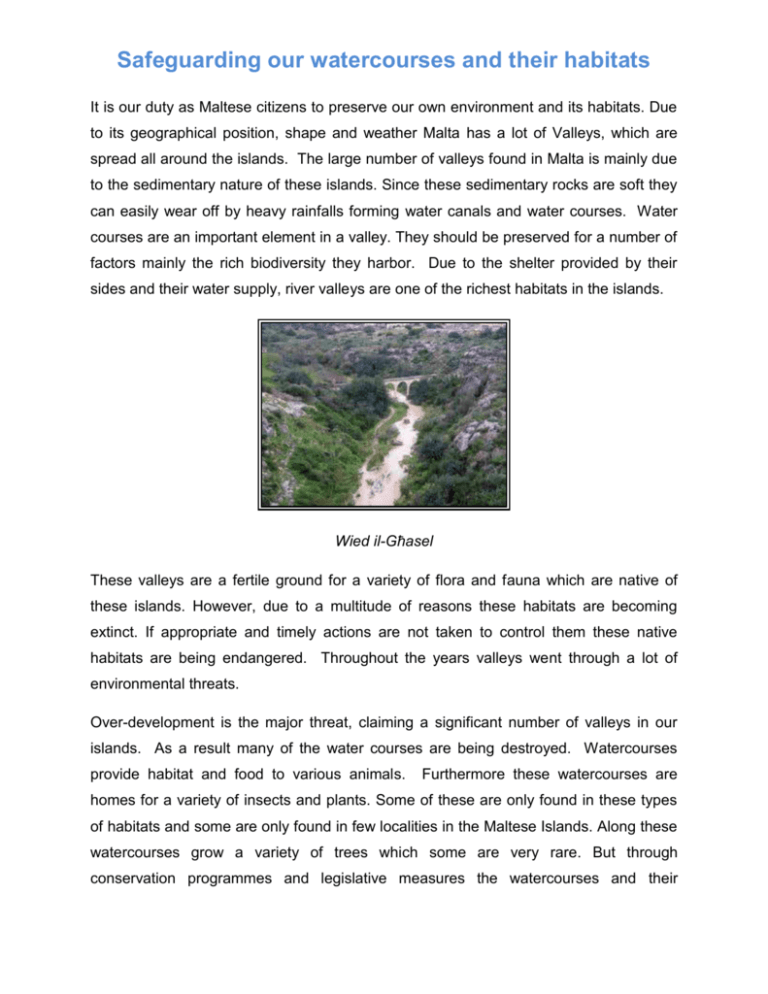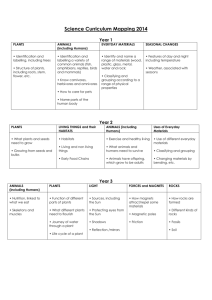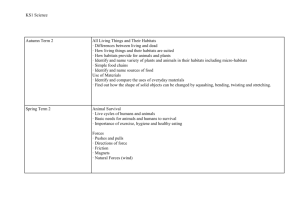Safeguarding our watercourses and their habitats
advertisement

Safeguarding our watercourses and their habitats It is our duty as Maltese citizens to preserve our own environment and its habitats. Due to its geographical position, shape and weather Malta has a lot of Valleys, which are spread all around the islands. The large number of valleys found in Malta is mainly due to the sedimentary nature of these islands. Since these sedimentary rocks are soft they can easily wear off by heavy rainfalls forming water canals and water courses. Water courses are an important element in a valley. They should be preserved for a number of factors mainly the rich biodiversity they harbor. Due to the shelter provided by their sides and their water supply, river valleys are one of the richest habitats in the islands. Wied il-Għasel These valleys are a fertile ground for a variety of flora and fauna which are native of these islands. However, due to a multitude of reasons these habitats are becoming extinct. If appropriate and timely actions are not taken to control them these native habitats are being endangered. Throughout the years valleys went through a lot of environmental threats. Over-development is the major threat, claiming a significant number of valleys in our islands. As a result many of the water courses are being destroyed. Watercourses provide habitat and food to various animals. Furthermore these watercourses are homes for a variety of insects and plants. Some of these are only found in these types of habitats and some are only found in few localities in the Maltese Islands. Along these watercourses grow a variety of trees which some are very rare. But through conservation programmes and legislative measures the watercourses and their environment are being safeguarded. Preserving valleys and their habitats is one of the main concerns which are being tackled. Through a concerted effort from Nature Trust (Malta), other non-Governmental Organizations and the Government these valleys and their habitats are being safeguarded. Habitat protection can be done in a variety of ways. Habitat protection is the key in protecting our rare, threatened, and endangered species. A typical example is Wied il-Musa. It has suffered from constructional structures that severely damaged its habitat. To protect further damage a conservational project started to protect endangered species and other habitats. It is a valley system located in Mellieha on the way to Cirkewwa. Wied Musa Among the many plants that grow at Wied il-Musa, the Long–brackted Sedge is among the species that was in danger of extinction. This plant grows along the valley bottom where pools of water accumulate during the wet season. This is the natural environment where the Longbrakted Sedge grows. But unfortunately its habitat has gone through a lot of changes compromising its existence. Part of the watercourse which supplies water to the valley was blocked by the construction of dams across the valley floor. It used to support a saline marshland at the mouth of the valley. This was partially destroyed when a temporary road was constructed on it. endangered species the road was closed. Eventually to protect this Longbrakted Sedge Legislation plays an important part in the protection of endangered species. In an effort to protect the remaining habitats and the endangered species within this locality, The Malta Environment and Planning authority (MEPA) listed Wied Musa as a Level 1 Site of Scientific Protection. This means that Wied il-Musa and its habitats were given the highest protection possible Another action taken was that the Long–Brackted Sedge was transported from its only known locality at Wied il-Musa to the Marsaxlokk Saline Marshland where it regenerated on its own. Unfortunately, similar to Wied il-Musa, the Marsaxlokk Saline Marshland was being used as a dumping site for rubble excavated from the Power Station site. But thanks to Nature Trust (Malta) the Marsaxlokk Saline Marshland was declared as a Nature Reserve in 1983. This site was converted to its natural status and consists of systems of canals and a ditch around a higher part of land. Marsaxlokk Saline Marshland Agriculture can too be of a threat to watercourses. The type of fertilizers farmers use in their farmland can have a negative impact on the watercourses themsleves further damaging the habitats they possess. This is due to the nurients and substances these fertilizers have resulting in seepage of these nutients to the watercourses. It is being recommended that farmers use man-made manure as fertilizers. Thus appropriate use of farmed land can drastically avoid certain species from extinction. Maintenance and appropriate cleaning of watercourses and valley beds are helping in the recovery of valleys. Noting the uniqueness and importance of watercourses, including the rarity of a number of species inhabiting them, their protection is of great significance. This needs to start from each and every one of us. One needs to appreciate that these form part of Malta`s natural heritage.







